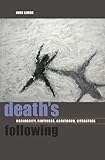Death's Following : Mediocrity, Dirtiness, Adulthood, Literature / John Limon.
Material type: TextPublisher: New York, NY : Fordham University Press, [2022]Copyright date: ©2012Description: 1 online resource (212 p.) : 2 Illustrations, black and whiteContent type:
TextPublisher: New York, NY : Fordham University Press, [2022]Copyright date: ©2012Description: 1 online resource (212 p.) : 2 Illustrations, black and whiteContent type: - 9780823242801
- 9780823291342
- online - DeGruyter
| Item type | Current library | Call number | URL | Status | Notes | Barcode | |
|---|---|---|---|---|---|---|---|
 eBook
eBook
|
Biblioteca "Angelicum" Pont. Univ. S.Tommaso d'Aquino Nuvola online | online - DeGruyter (Browse shelf(Opens below)) | Online access | Not for loan (Accesso limitato) | Accesso per gli utenti autorizzati / Access for authorized users | (dgr)9780823291342 |
Browsing Biblioteca "Angelicum" Pont. Univ. S.Tommaso d'Aquino shelves, Shelving location: Nuvola online Close shelf browser (Hides shelf browser)

|

|

|

|

|

|

|
||
| online - DeGruyter Crediting God : Sovereignty and Religion in the Age of Global Capitalism / | online - DeGruyter Critical Views : Essays on the Humanities and the Arts / | online - DeGruyter Crossover Queries : Dwelling with Negatives, Embodying Philosophy's Others / | online - DeGruyter Death's Following : Mediocrity, Dirtiness, Adulthood, Literature / | online - DeGruyter Debates in Continental Philosophy : Conversations with Contemporary Thinkers / | online - DeGruyter Decolonizing Epistemologies : Latina/o Theology and Philosophy / | online - DeGruyter Derrida Vis-à-vis Lacan : Interweaving Deconstruction and Psychoanalysis / |
Frontmatter -- Contents -- Text and Doctrine: Adulthood and Dirtiness -- 1. Preliminary Expectoration -- 2. Alas a Dirty Third: Th e Logic of Death -- Reasons: Mediocrity, Melancholy, and Play -- 3. Thomas Bernhard’s Rant -- 4. Following Sebald -- 5. Tickling the Corpse: Tom Stoppard’s Memento Mori -- Uses: Coming to Death in Autobiography and Culture -- 6. Don Rickles’s Rant -- 7. Too Late, My Brothers -- 8. Re: Barth -- Notes -- Index
restricted access online access with authorization star
http://purl.org/coar/access_right/c_16ec
Almost all twentieth-century philosophy stresses the immanence of death in human life—as drive (Freud), as the context of Being (Heidegger), as the essence of our defining ethics (Levinas), or as language (de Man, Blanchot). In Death’s Following, John Limon makes use of literary analysis (of Sebald, Bernhard, and Stoppard), cultural analysis, and autobiography to argue that death is best conceived as always transcendentally beyond ourselves, neither immanent nor imminent. Adapting Kierkegaard’s variations on the theme of Abraham’s near-sacrifice of Isaac while refocusing the emphasis onto Isaac, Limon argues that death should be imagined as if hiding at the end of an inexplicable journey to Moriah. The point is not to evade or ignore death but to conceive it more truly, repulsively, and pervasively in its camouflage: for example, in jokes, in logical puzzles, in bowdlerized folk songs. The first of Limon’s two key concepts is adulthood: the prolonged anti-ritual for experiencing the full distance on the look of death. His second is dirtiness, as theorized in a Jewish joke, a logical exemplum, and T. S. Eliot’s “Ash Wednesday”: In each case, unseen dirt on foreheads suggests the invisibility of inferred death. Not recognizing death immediately or admitting its immanence and imminence is for Heidegger the defining characteristic of the “they,” humanity in its inauthentic social escapism. But Limon vouches throughout for the mediocrity of the “they” in its dirty and ludicrous adulthood. Mediocrity is the privileged position for previewing death, in Limon’s opinion: practice for being forgotten. In refusing the call of twentieth-century philosophy to face death courageously, Limon urges the ethical and aesthetic value of mediocre anti-heroism.
Mode of access: Internet via World Wide Web.
In English.
Description based on online resource; title from PDF title page (publisher's Web site, viewed 03. Jan 2023)


